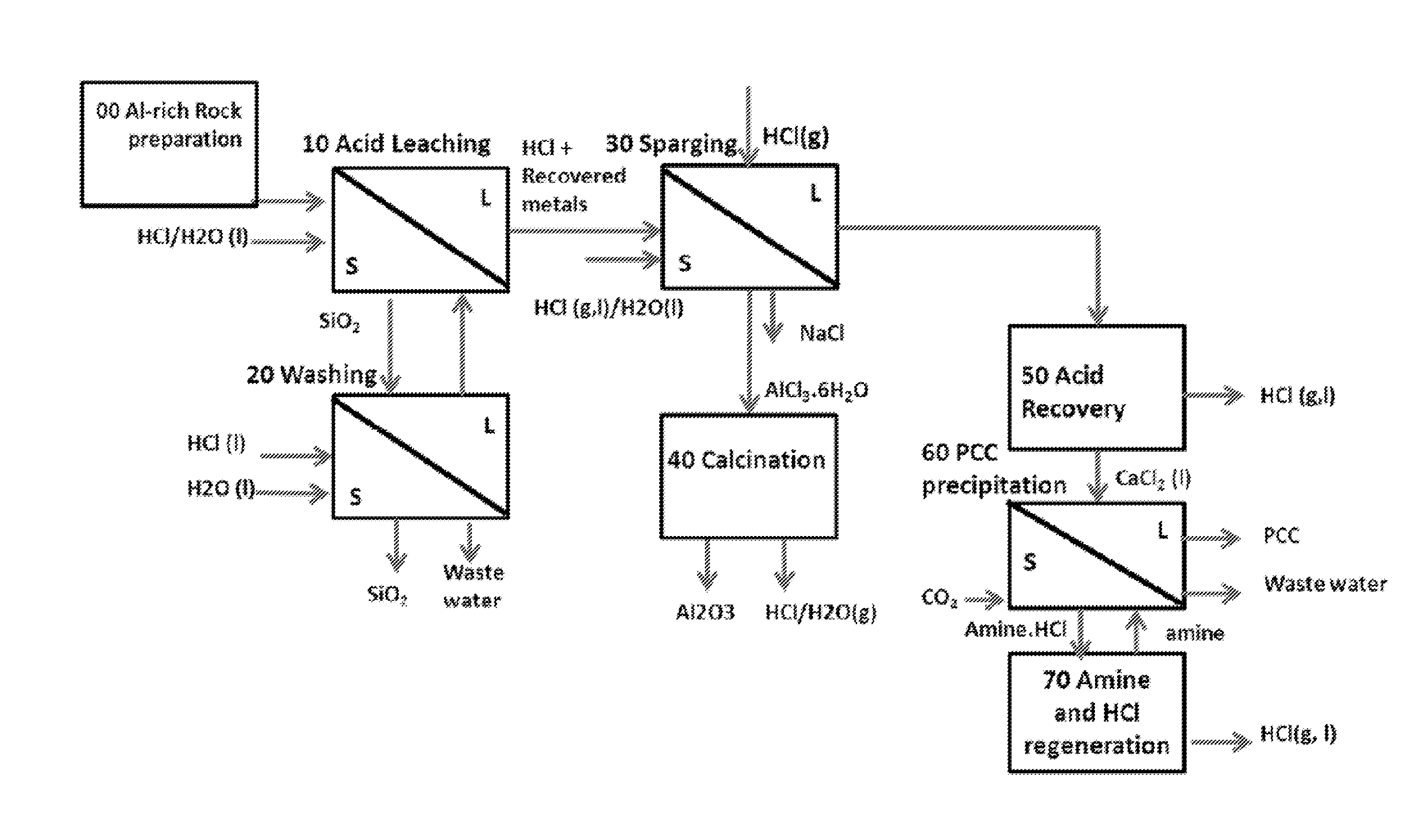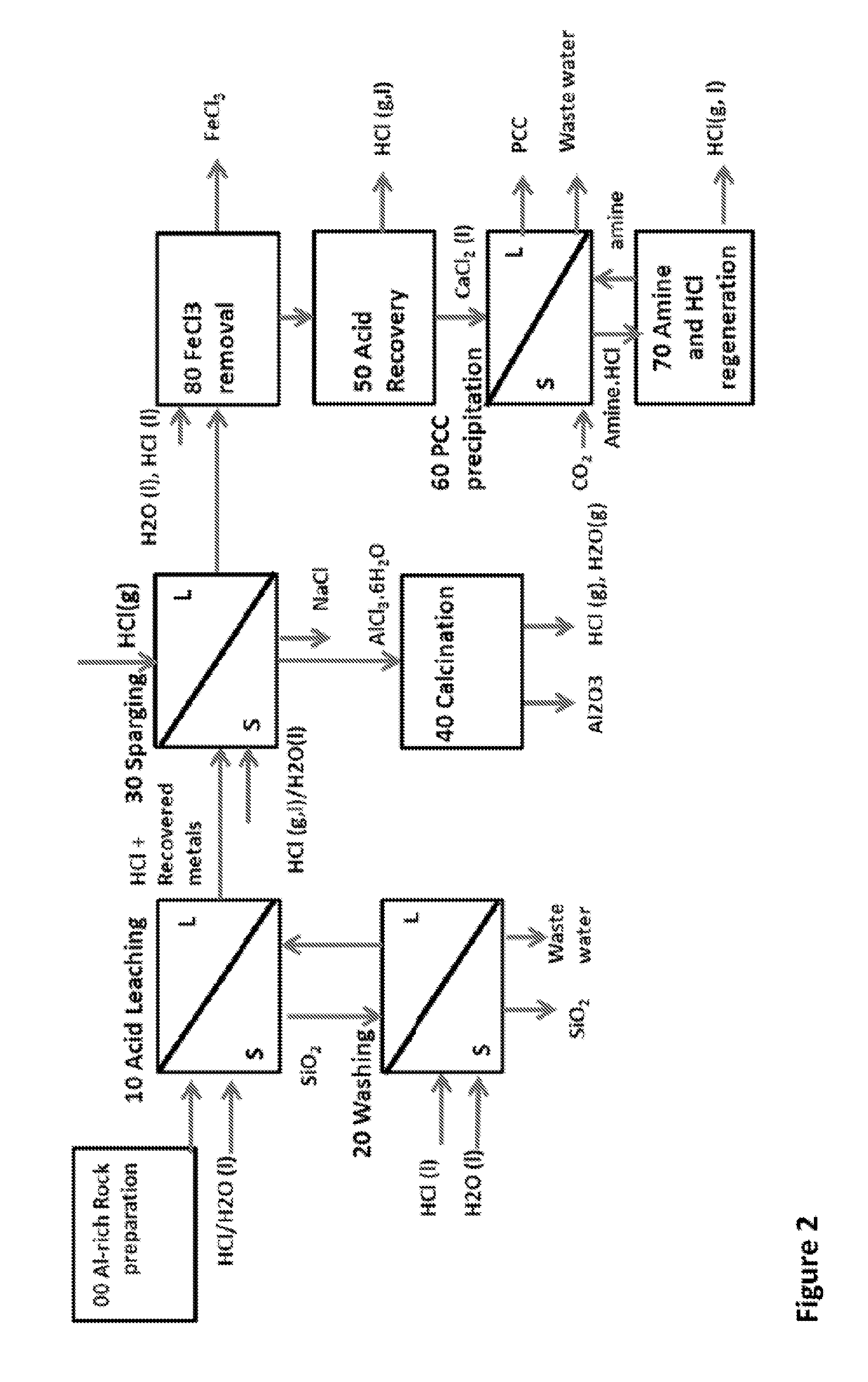ALUMINA AND CARBONATE PRODUCTION METHOD FROM Al-RICH MATERIALS WITH INTEGRATED CO2 UTILIZATION
- Summary
- Abstract
- Description
- Claims
- Application Information
AI Technical Summary
Benefits of technology
Problems solved by technology
Method used
Image
Examples
example 1
Leaching
[0083]In a reactor of 100 liters design capacity, 15 kg of anorthosite slurry in water (33 wt % water) is mixed with 38 l of a preheated HCl solution (22 wt % HCl) at 70° C. The anorthosite particle size is 300 micron. The mixture is further heated up to 140° C. (with steam flowing through the reactor steam-jacket), building a pressure of 2.5 bar, under vigorous mechanical stirring. The total reaction time from the mixing point is 5 hours. Samples of the mixture are taken at 2.5 and 5 hours, filtered and analysed by ICP-MS (Ion Coupled Plasma with Mass Spectrometer). The measured aluminium recovered from the anorthosite to the liquid fraction is 88 wt % at 2.5 h and 95 wt % at 5 hours.
example 2
HCl Extraction and Metal Carbonate Precipitation with Different Amines
[0084]Several types of amine solutions were tested to evaluate the influence of the chemical nature of the active organic phase on the PCC technology. The chemical properties of the amine function are related to the capacity of the free electron pair of the N atom to form hydrogen bonds. In case of an acid extraction process, the strength of the amine (extraction capacity) is also determined by the availability of its unshared electron-pair to an electrophilic proton of the acid to extract. This availability is determined by the inductive effect of the atoms and chains bonded to the N atom (Eyal et al. (1991)). Due to the inductive effect of substituting H by an aliphatic chain, tertiary amines are expected to have a higher basic strength than primary and secondary amines. In addition, basicity is expected to increase with the length of the aliphatic chain.
[0085]In this technology, the basic strength of the amine ...
example 3
Calculation of the Necessary Stages for HCl Extraction
[0092]From the different experimental tests, one representative case was selected to determine the required countercurrent stages by applying an adapted McCabe Thiele diagram method. In this case, the organic phase was the Tri-iso-octylamine (TiOA) with an amine to organic dilutants ratio of 1:1 (vol) and decanol and asol as dilutants in a proportion of 2:1 vol. The McCabe-Thiele method is widely used in metallurgy for pre-engineering and pilot design since it gives a good approximation of the volumes, stages, concentrations, etc. with relatively low complexity. The distribution curves or equilibrium isotherms are experimentally obtained under the process conditions, and represent the final concentration of a dissolved component in the two phases (aqueous and organic) when the mixture reaches the equilibrium. The proof-of-concept based on process solutions and the generation of accurate engineering data can only be done in a pilo...
PUM
| Property | Measurement | Unit |
|---|---|---|
| Temperature | aaaaa | aaaaa |
| Temperature | aaaaa | aaaaa |
| Temperature | aaaaa | aaaaa |
Abstract
Description
Claims
Application Information
 Login to View More
Login to View More - R&D
- Intellectual Property
- Life Sciences
- Materials
- Tech Scout
- Unparalleled Data Quality
- Higher Quality Content
- 60% Fewer Hallucinations
Browse by: Latest US Patents, China's latest patents, Technical Efficacy Thesaurus, Application Domain, Technology Topic, Popular Technical Reports.
© 2025 PatSnap. All rights reserved.Legal|Privacy policy|Modern Slavery Act Transparency Statement|Sitemap|About US| Contact US: help@patsnap.com



